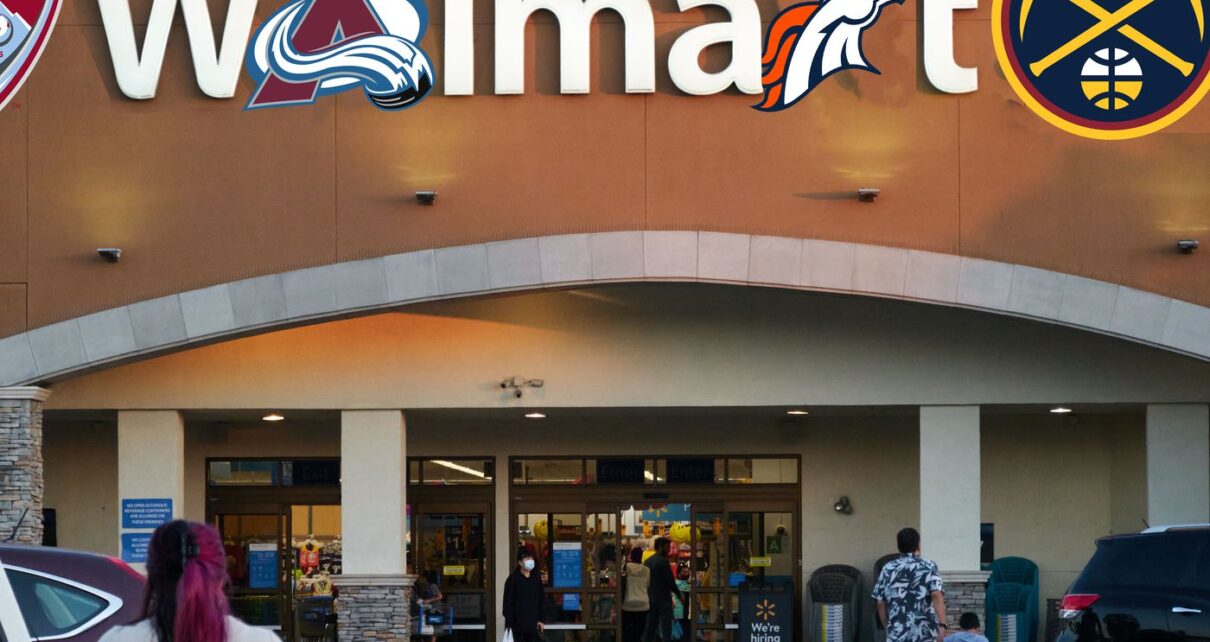A wash of Walton family funding to news media is creating echo chambers in environmental journalism, and beyond. Are editorial firewalls up to the task?
By Bill Lascher

Civil Eats illustration

The Long Reach of the Walmart-Walton Empire

Walmart’s ‘Regenerative Foodscape’

Op-ed: Walmart’s Outsized Catch
This article was co-produced and co-published with Nonprofit Quarterly.
From vast riparian watersheds to fisheries to croplands, few corners of the nation’s—and the world’s—food systems have escaped the eyes of the Walton family. The children and grandchildren of Walmart co-founder Sam Walton have long embedded their interests, and, more importantly, their money, among industry groups, policymakers, academics, activists, and NGOs active in the future of food. Now, they’re expanding their philanthropy to news organizations that report on food, agriculture, and the environment and, in turn, amplifying the family’s other efforts.
The Waltons aren’t the only philanthropists pumping money into the news industry, and the family, America’s richest, gives even larger sums to other interests. But with increasing emphasis over the past decade, the Walton Family Foundation and individual family foundations have directed tens of millions of dollars to support journalists, newsrooms, and journalism organizations whose coverage overlaps with subjects about which Walton family members are passionate—and passionately funding.
Aside from the Walton Family Foundation, Walton family members also give to causes and to journalism through other foundations including the Catena Foundation, Builders Initiative, the Penner Family Foundation, the Wend Fund, and the Zoma Foundation.
Read all the stories in our series:
- Overview: The Long Reach of the Walmart-Walton Empire
In this ongoing investigative series, we take a detailed look at Walmart and its founding family’s influence over the American food system, over the producers and policymakers who shape it, and how its would-be critics are also its bedfellows. - Walmart’s ‘Regenerative Foodscape’ Walmart’s efforts to redefine itself as a regenerative company are at odds with its low-cost model, and combined with the Walton family’s vast investments in regenerative agriculture, have the potential to remake the marketplace.
- Walmart and EDF Forged an Unlikely Partnership. 17 Years Later, What’s Changed? We talk with Elizabeth Sturcken for an up-close look at the sustainability alliance between the environmental nonprofit and the retail behemoth.
- Op-ed: Walmart’s Outsized Catch: Walmart and the Walton Family Foundation have relied on a debatable definition of “sustainable” seafood that allows it to achieve its sourcing goals without fundamentally changing its business model.
- Diving—and Dying—for Red Gold: The Human Cost of Honduran Lobster: The Walton Family Foundation invested in a Honduran lobster fishery, targeting its sustainability and touting its success. Ten years later, thousands of workers have been injured or killed.
- Walmart’s Pandemic Port Squeeze: While most retailers dealt with congested ports and unprecedented shipping prices, Walmart chartered its own ships, increased sales, and used its market gains to sideline competitors. Then it weighed in on shipping reform.
- Walmart Heirs Bet Big on Journalism: A wash of Walton family funding to news media is creating echo chambers in environmental journalism, and beyond. Are editorial firewalls up to the task?
Journalism is welcoming the new infusion of philanthropy. Since the decline of the industry’s ad-driven business model was hastened by the Great Recession, more than half of newspapers have shuttered across America and the industry has shed more than 20,000 jobs. Thirteen years ago, fewer than a dozen digital news nonprofits led the charge to shift news to a nonprofit model. Now, there are more than 400 digital news nonprofits nationwide, supported by an ever-growing coalition of philanthropies that include the Walton charities.
It’s not just digital news nonprofits that benefit from their giving; the Waltons also give to legacy newspapers, websites, magazines, radio stations, and trade journals covering such subjects as agriculture, water policy, fisheries, conservation, and climate. That giving has grown even as the family has increased its funding of groups that discuss, study, or promote policy related to these subjects and often drive the news that Walton-funded outlets cover.
There’s more. As Civil Eats has documented, Walmart, the family business, has over the past two decades used its economic and political muscle to lower the bar for what qualifies as “organic” foods and “sustainable seafood” and the Walton Family Foundation has also supported seafood sustainability projects that didn’t ensure safe practices for Central American lobster divers.
Notably, Walton family journalism philanthropy is focused in overlapping areas. The foundation board is legally independent of Walmart. And grants are promised with no strings attached. Nonetheless, with journalists accepting hundreds of millions of dollars in Walton philanthropy, it is important to consider how news coverage may be affected.
Indeed, Walton family funding is so widespread that environment-focused reporters working for nonprofit news organizations funded by Walton philanthropy often cover, interview, or analyze organizations and individuals who are also grantees of the family’s foundation and/or family members’ individual foundations. As the field of potential sources not supported by the Waltons narrows, reporters risk tilting discussions about sustainability, resource management, conservation, or other subjects toward solutions favored by the family’s philanthropies.
“The Walton Family Foundation works from the belief that fact-based, independent journalism is essential to making sure communities have the information they need on the issues that matter most,” said Walton Family Foundation spokesman Mark Shields in a statement to Civil Eats. “Journalists and outlets—including Civil Eats—who receive support from the foundation have full editorial control over their content.” (Civil Eats does not accept grants and donations from the Waltons or their associated charities, although Civil Eats has indirectly received such funding through its work with other partners.)
Observers of the industry, however, are concerned about a new era in journalism in which a limited class of grantmakers is defining narratives and the flow of information.
Will Sennott, a staff reporter with the nonprofit Massachusetts newsroom The New Bedford Light, said reporting on fisheries in New England is complicated because “the world of fisheries policy of today is one that was molded by the Walton Family Foundation.” He said the foundation’s prior grants to NGOs enabled its priorities to seep deep into policymaking through the appointments of its grantees to the regulatory councils that govern American fisheries.
Now, “it’s hard to even extract their influence from fisheries policy,” Sennott said. “When it comes to groundfish especially, all fisheries policy today is based entirely on the kind of policies they peddled about 10-12 years ago.”
The Walton Family Foundation and some individual Walton family members’ own foundations continue to support organizations and media, including trade journals and industry newsletters, that target agriculture and fisheries. They have made engagement on “restorative aquaculture” one of their philanthropic planks, funding numerous ventures on both sides of the notebook.
“When it comes to groundfish especially, all fisheries policy today is based entirely on the kind of policies [Walmart and the Walton family] peddled about 10-12 years ago.”
For example, Lukas Walton chairs the family foundation’s environmental program and, since 2021, has supported journalism-related nonprofits—such as Chicago Public Media, Grist, Sentient Media, and the Reader Institute for Community Journalism—through his private foundation, Builders Initiative. Builders Initiative also gives extensively to seafood and ocean conservation related programs.
Much of Builders’ grantmaking in these areas also supports Walton Family Foundation beneficiaries like the Nature Conservancy and the World Wildlife Fund for programs focused on such subjects as “market-based solutions for Kelp Recovery” and “Seaweed and Mollusks aquaculture,” as well as the “aquaculture media strategy” of seafood advocacy organization, Stronger America Through Seafood, Inc.
The Walton Family Foundation also supports SeafoodSource, the leading industry publication for seafood news. It’s hard for SeafoodSource, or anyone discussing sustainable seafood, to ignore the Walton Family Foundation and other Walton family organizations and interests and the perceptions readers might have about their influence on SeafoodSource’s coverage.
“That’s a really tough one because Walton has their fingers in almost every nonprofit in sustainable seafood,” said Ned Daly, who is a contributing editor at SeafoodSource and a sustainability strategist for its parent company, Diversified Communications. Daly manages grants made by the Walton Family Foundation in support of SeafoodSource’s “Seafood2030” platform. “I think it would be hard to not engage with those groups or work with those groups but in terms of special treatment, I think it’s really more what’s newsworthy and what’s going to drive interest in stories.”
Daly, who writes about sustainability, says the Walton Family Foundation doesn’t have a say in the publication’s coverage, much like other funders of Diversified Communications’ products as well as advertisers in SeafoodSource. But foundations and nonprofits in general, Daly said, do occasionally benefit from blurred lines in Diversified’s content, if to a lesser degree at SeafoodSource.
For the perennially underfunded business of journalism, the idea of using editorial firewalls has served as the best defense against funders seeking to influence reporting. But in the case of Walmart, the Walton Family Foundation, and its family members’ many individual foundations, the funding can saturate an entire region or subject, meaning that reporters doing their jobs simply can’t avoid the Walton family’s influence.
For the perennially underfunded business of journalism, the idea of using editorial firewalls has served as the best defense against funders seeking to influence reporting.
“It’s a sin of omission, not of commission,” said Joel Dyer, the former editor of The Boulder Weekly in Colorado. Dyer spoke to Civil Eats at length about the challenges of reporting on water issues in areas where the Walton family and their foundations have extended their philanthropic nets.
“It’s problematic,” Dyer said. “It’s beyond problematic. In essence there is evidence of oil companies paying for energy coverage, the Waltons paying for water coverage. Nothing actually sort of pisses me off more. Journalists of all people know better than to say, ‘Well, hey, it doesn’t influence what I write.’ We’ve been covering academics that take money from Monsanto and good lord everybody, and we know how much it influences what they do. And journalism is no different.”
Louisiana-based photojournalist Julie Dermansky shares the view that editorial firewalls don’t sufficiently prevent meddling by newsroom funders. Fishermen and others in the Mississippi Delta’s seafood industry have lost all trust in local media, she said, because Walton-backed media and the NGOs working in the area, including many backed by the Waltons, combine to amplify narratives that drown out and marginalize fishermen’s views and avoid reporting that is at cross-purposes with Walton aims.
“I think it’s naive to think you could take massive amounts of money from an organization and then write about other organizations it gives money to,” Dermansky said.
She said fishermen are at odds with a Mississippi River diversion project that’s supported by the Waltons and environmental groups in the delta. In an article published last year in DeSmog, Dermansky notes local fishermen’s belief that the Walton Family Foundation and Walmart’s interests align with the oil and gas industry in the Gulf: By implementing the Mid-Barataria Sediment Diversion project, independent fishermen’s livelihoods will be destroyed, they say, while also removing a check-and-balance their presence has on offshore oil and gas drilling in the same region, she said.
“I think it’s naive to think you could take massive amounts of money from an organization and then write about other organizations it gives money to.”
The Louisiana fishing industry is one of the last substantial, competitive, independent fishing industries in the world, she said, a dynamic that challenges Walmart’s market dominance. “So you get rid of them, and then they’ve got the market,” said Dermansky, referring to Walton family interests. “There’s an overlap with the desire of oil and gas and the Walton foundation in the case of the Mississippi River because fishermen are a pest for the oil and gas industry because they’re the eyes and ears” on the waterway, she said.
Striking a balance between funding journalism and continuing to use that journalism to hold the powerful accountable is an ongoing struggle. Sara Shipley Hiles, executive director of the Mississippi River Basin Ag & Water Desk, a reporting project based at the University of Missouri that is funded in large part by the Walton Family Foundation, said concerns about the Waltons’ involvement are a reality for newsrooms.
“These issues are not new and they’re not exclusive to nonprofit journalism,” Shipley Hiles said. “Every business, nonprofit or for-profit, have funding sources. We all have to answer for that. Civil Eats has to answer for that.”
“The Walton Family Foundation has been an outstanding funder,” said Shipley Hiles. “From the beginning we were clear that we had to have editorial independence and they did not push back against that. They’ve funded journalists enough now and I think folks who came before us were very clear on that. I can thank all the previous grantees as well for making it very clear that this is how journalism works. Without editorial independence, we have no credibility. We absolutely, fundamentally, must have editorial independence.”
Journalism produced by Mississippi River Basin Ag & Water Desk reporters includes disclosures of Walton Family Foundation funding in part to address concerns about funder influence on reporting.
But what are the impacts on public understanding of complex issues, and on the availability of reporting on important topics, when one interlinked set of funders is so omnipresent? If a reporter can’t find a reputable source without ties to Walton money, how does that inform what news gets published?
History Repeats, in New Ways
Jim Friedlich is executive director and CEO at the Lenfest Institute, a philanthropy that exclusively supports local journalism. He says the tension between journalism and its funding is not at all new. He said, when done well, nonprofit journalism is “non-partisan, inclusive, and reflective of a broad array of voices across the political spectrum or field of ideas.”
Friedlich said Lenfest works to support multiple news organizations in one place to promote a diversity of ideas and concepts, and points to two examples: Spotlight PA, a nonpartisan statewide news organization in Pennsylvania, which distributes government accountability journalism for free. And Every Voice, Every Vote, which covered recent city elections in Philadelphia through grants to 25 different news organizations from nearly every neighborhood, ethnic, and racial group or political affiliation. “The effect was a broad and echo-free journalistic exploration of the issues at hand,” Friedlich added.
We’ll bring the news to you.
Get the weekly Civil Eats newsletter, delivered to your inbox.
Most philanthropy in journalism doesn’t fit that profile, instead funding issue-based work in areas where foundations and donors also concentrate their giving.
“If your first initiative is education, then your second should be news and information around those topics,” said Tyler Tokarczyk, a senior program officer at the Inasmuch Foundation, which focuses on journalism and education. “You should be looking to elevate the conversations around issues in your community that are important to the foundation. I think that’s very common. The need for news and information in nonprofit journalism is pretty overwhelming across the country.”
Indeed, the need for support for local journalism is so acute that a coalition of philanthropies recently came together to seed a $500 million effort called Press Forward to put more reporters in underserved communities.
It is in funding-saturated areas where the sheer volume of giving presents new challenges. In the case of the Waltons, seafood and watershed programs are densely packed with Walton-backed initiatives, as is the attending journalism.
For example, the Walton Family Foundation has had a years-long relationship with the Society of Environmental Journalists (SEJ), an organization that has long attempted to mirror news outlets’ “church and state” separations between editorial and business operations. Those separations have become more complicated as SEJ funders, including the Walton Family Foundation and groups to which the family has heavily donated, have become more visibly involved in the organization’s events and publications.
Civil Eats is a member of SEJ, and while Civil Eats has striven to not accept funding from the Walton Family Foundation or the individual family foundations, it has been the recipient of grants that might have been funded by Walton Family Foundation donations.
For example, in partnership with Earth Island Journal, Civil Eats produced this story, which was supported by an SEJ grant, and was likely originally sourced from Walton Family Foundation funding, unbeknownst to Civil Eats. Despite some newsrooms’ stringent efforts to avoid Walton Family Foundation funding, it remains widespread in nonprofit news.
Since 2013, SEJ has received more than $1.8 million from the Walton Family Foundation to help develop specialized environmental reporting initiatives and support conferences and other events. SEJ’s former executive director, Meaghan Parker, insisted on a stark line between the fundraising that she oversees and editorial operations, like the content of its conferences and publications, which is managed by member volunteers.
“I talk with the money people,” Parker said, who stepped down from the executive director position at the end of 2023 and is now a senior advisor to SEJ. During her time as executive director, she added that she turned down “huge” sums from potential funders, and that every grant SEJ receives has clearly spelled-out stipulations about its strict firewalls. “In every grant agreement that SEJ has with any funder, we have a line in there that says the donor and the funder have no right of interference or the review in editorial decisions made by the SEJ,” she said.
The Walton Family Foundation’s Shields confirms that journalists who receive support from the foundation have full editorial control, and that the foundation’s priority is fact-based information on important topics.
“For example, in the early phase of the pandemic, the Walton Family Foundation contributed funds to the Society of Environmental Journalists’ Rapid Response emergency story grants,” Shields said in a statement. “Those funds were especially important for environmental journalists at a time when an unprecedented number of jobs were being cut, leaving fewer reporters to cover critical issues.”
Flooding the Colorado River with Walton Funding
Time will tell how much journalism—and the public—will benefit from philanthropic support, but the public relations benefit for donors is clearer. Philanthropic support of newsrooms and reporters is an explicitly stated piece of the Walton Family Foundation’s strategic planning since 2021, and the foundation has been laying the groundwork for this strategy for the better part of a decade.
Perhaps nowhere is the strategic intent more evident than in the family’s myriad investments in the Colorado River Basin, whose waters and surrounding lands are—and have long been—among North America’s most prized and, increasingly, most imperiled, natural resources, and in reporting about the basin. The Walton Family Foundation, Catena Foundation, Wend Foundation, and the Penner Family Foundation (the family foundation of Carrie Walton Penner and her husband, Greg Penner) have all funded journalism in the basin.
These foundations, as well as Zoma Foundation and the Rob and Melani Walton Foundation, have all philanthropically supported other non-journalism initiatives in the basin, and many of the Walton family’s associated businesses have invested in the region.
Since 2016, the Walton Family Foundation has directed more than $200 million in funding to grantees both inside and outside journalism with emphasis on the Colorado River. They’ve been a crucial part of the conversation about the future of the river and the water it provides to the 38,900 farms that generate about $47 billion a year in economic impact.
The Waltons aren’t alone among large grantmakers interested in the Colorado River. For example, in 2016, the Walton Family Foundation formed the Water Funder Initiative in collaboration with six other philanthropies. That collaboration began with these philanthropies committing $10 million over five years to support restoration and management of California’s Salton Sea, an imperiled inland water body in California near the terminus of the Colorado.
Since 2016, the Walton Family Foundation has directed more than $200 million in funding to grantees both inside and outside journalism with emphasis on the Colorado River.
Since at least 2017, the Walton Family Foundation has given millions of dollars to the Water Funder Initiative by way of an Arabella Advisors-managed fund, the Windward Fund, which described its mission at the time as advancing “public awareness about conservation, climate, and environmental issues, sustainable food systems, and the protection of land, wildlife and natural resources.”
Arabella Advisors guides the philanthropy of other Walton family members’ foundations, often through such funds. At least three other members of the Water Funder Initiative gave through the Windward fund. (In 2022, Civil Eats received a $5,000 unrestricted grant from New Venture Fund, which is also managed by Arabella Advisors.)
The same year as the Salton Sea donation, the Water Funder Initiative published Toward Water Sustainability, which it summarized as a “Blueprint for Philanthropy.” This blueprint outlines six “funding action plans” for future water-related giving. One of these plans focused on “Communications and Political Will” and aimed to “identify near-term opportunities, such as expanded water journalism, to improve the field’s communications capacity, build political will, and cultivate diverse constituencies needed to support water reforms.”
The Waltons’ support of SEJ and their seeding of the Colorado River Basin and Mississippi reporting hubs suggest serious interest in how the public discusses the interplay between the human and natural world in the 21st century. One of the goals for the Walton Family Foundation’s most recent giving cycle: learning “how our journalism support could help us better serve communities that may not have access to trusted, accurate, and relevant information.”
That focus has continued through this year, as Walton Family Foundation Communications Director Daphne Moore wrote this November in a report reflecting on a year of community journalism grantmaking.
“We want to learn the most innovative and cost-effective ways to reach diverse sectors of communities through journalism and the news,” Moore wrote.
“I joked about it with a colleague that every time I do an interview, now my last question is, ‘We disclose funding relationships in our reporting, is any of your current work receiving funding from the Walton Family Foundation?’” said Luke Runyon, whose reporting on the Colorado River has been funded by Walton family money since 2017.
That year, Runyon launched the Colorado River Reporting Project at KUNC, a public radio station and NPR affiliate in Greeley, Colorado. Grant money from the Walton Family Foundation funded the position. In leaving KUNC in 2023 for his current position as co-director at the Water Desk, he joined an environmental journalism initiative that the Waltons played an integral role in launching.
Based at the University of Colorado in Boulder, the desk provides focused, ongoing coverage of water issues in the Western U.S., especially the Colorado River Basin and provides grants to reporters to execute that work. It was launched with a $700,000, two-year grant from the Walton Family Foundation, which made additional grants of $600,000 and $900,000 to the Water Desk in 2021 and 2023.
The Walton Family Foundation always respected the editorial control Runyon insisted on, he said. “There was never really an instance where I felt any sort of undue pressure on what to cover as a reporter.” He also made it a policy to disclose as best he could if a source took funding from the foundation as well.
Now that he’s out of the KUNC position, Runyon believes the transparency improved his reporting, after asking about the family’s involvement so regularly became his “running joke.” He told Civil Eats that there’s no avoiding the Waltons’ presence in the Colorado River Basin, whether through the Walton Family Foundation, individual Walton family members’ separate private foundations, or their business or personal interests, like rafting.
“I feel like I knew the landscape pretty well, but that was something that we felt was really important to tell people,” Runyon said. “Not just our relationship to this particular foundation, but also that some of the sources that we’re talking to also have this relationship.”
The ubiquity of Walton-related funding can muddy the waters for reporters covering the beat. A November 2023 article by Annie Ropeik in the SEJ’s online digital news magazine on approaches for reporting on environmental solutions and equity within watershed-level stories shows how pervasive this funding is.







